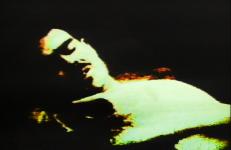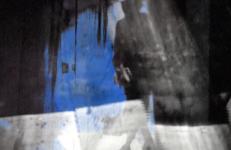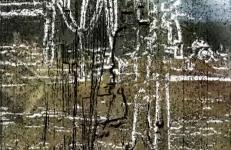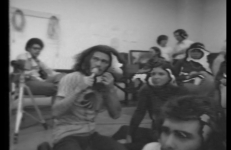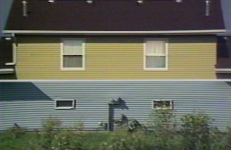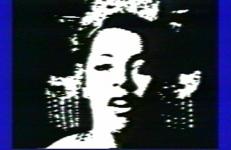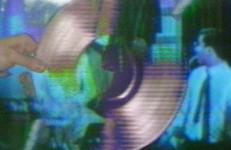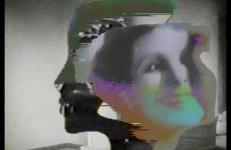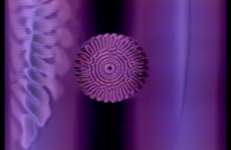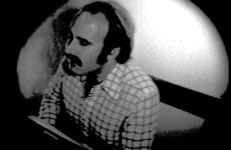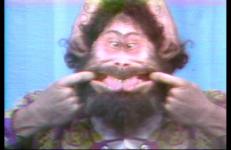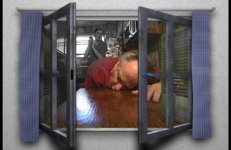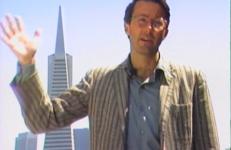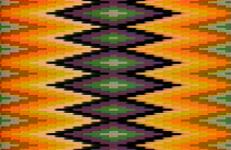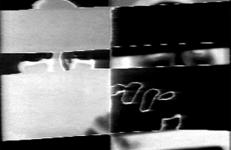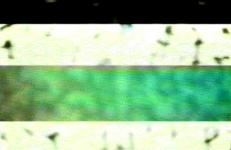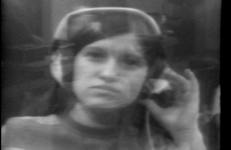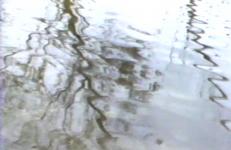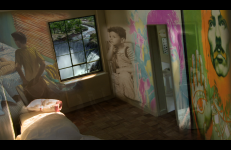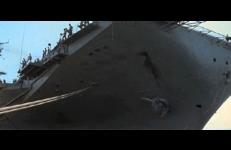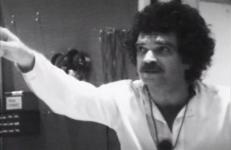“A short image-processed work, Thousands Watch deals with the issue of nuclear suicide. The tape’s central metaphor is derived from a 1936 Universal newsreel of a crowd looking on while a young man stands on the ledge of a tall building, threatening to—and eventually succeeding in—committing suicide. It begins with an image of time-lapsed colorized clouds racing across the sky at a frenzied pace while a low siren wail emerges on the soundtrack. This sound forms a pulsing heartbeat and builds into a tense crescendo as the tape progresses.
Image Processing
This is a later reworking of original video documenting the goings-on of the village, Tlocalula, Mexico in 1973.
This is a later reworking of original video documenting the goings-on of the village, Tlocalula, Mexico in 1973. Uses footage from Oaxaca 2004 in the background.
The video content—a live-feed image processing tape—shows intellectual discussion among SAIC Video Area students and faculty members. Instead of being a prescriptive monologue from school to students, Phil sits among the crowd and moderates the session. The decentralized and non-hierarchical academic setting—students and faculty sitting on the floor and cushions in a circle—is typical of the ’70s. At times, students burst into laughter, dancing, and lounging on the floor, hence creating a laid-back environment.
This tape deviates from the more purely formal investigations of Snyder’s earlier work; it has no soundtrack and uses camera images exclusively. Employing Quantel digital effects and editing procedures, a novelty in video post-production at the time, Snyder manipulates images of tract houses shot in a small Indiana town. Cubist re-constructions of the monotonous facades fracture spatial planes into intricate geometric arrangements, with frames enclosing frames, spiralling like Chinese boxes.
Part of a trilogy of works known as the Video Wallpaper Series in which George tests out his new audio/video digital mixer and creates a range of impressions of people and places. "A collage of serpent-infested gruel from Haitian hybrids." —George Kuchar
In Sonnier’s video tape TV In and TV Out, two images are superimposed, one shot off network television and the other shot from a studio performance situation involving some of the materials and visual qualities of his sculptures. This live image is colorized by a device which adds color to a black and white image and in turn manipulates the color. Colorized color is more opaque and less three-dimensionally tactile than synthesized color, but it is tactile in its video scan-line texture.
“The images mix fragments of the real and imaginary in a hermetic effort to express the [Breder's] quest for a visual text that is at once personal reflection and cultural criticism. ” - John Hanhardt, 1989
This meditative silent video features gradual evolving swirls on top of vertically synced bars. Their ever-changing color, shapes, and sizes demonstrate the subtleties achieved through image processing. The slow-paced kaleidoscopic glow invites the viewer to contemplate a dance of visual genesis.
–Gordon Dic-Lun Fung
For more information, visit the Phil Morton Memorial Research Archive page.
"A hand made raster deflection unit was used, inspired by Nam June Paik's video synthesizer system. I also used a TV repair person's test signal grid, early digital. Two b+w video cameras, audio oscillator sweeping up and then down. More keying permutations. Video, oscillator, keying, graphic timing buzzes."
– Peer Bode
Showcasing a solo organ recital, Victor Solo features seven sets of organ works. A narrator, possibly the organ player, announces work titles before each set. The video then displays superimposed views of the organist and the interior of the cathedral. Each set features a different angle of the organist and the architecture. Fitting to the tranquil chorale and preludes, the video artist gives minimal treatment with image processing.
PASSIONS run deep and LOVE flies high on Cupid’s arrow when ‘Boys’ are the desired target.
In this series I composed a series of portraits on my audio/video digital mixer, ranging from impressions of places and people to renditions of feelings their work inspired, and domestic-type gossip from the kitchen and bedroom. The gallery of images and sounds were fed into my gizmo and ground up into gourmet gruel. Includes: Isleton 3:20 Trinity 5:28 Kitchenetiquette 5:
Inspired by the analogy between weaving (vertical warp threads traversed by horizontal weft threads) and the construction of the television image (vertical and horizontal scans of an electron gun), Stephen Beck built the Video Weaver in 1974, and produced Video Weavings in 1976. The patterns in this tape are based on sequences of colors in dynamic mathematical progressions, inspired by non-representational Islamic art. Beck was also intrigued with the problem of synthesizing aspects of human perception.
Gusella's title creates a pun on the term video "tape" by using a split screen in which one half is the electronic negative of the other. Gusella set up a glass sheet and suspended it from light poles. The glass was covered with black or white tape. As he slowly removes the obscuring tape from one half of the screen, his ghostly negative image emerges, further confusing the viewer.
Blurred images, glowing like a foggy moon and reminiscent of early television broadcasts, are rhythmically set to a relentless, pulsing soundtrack.
This title is also available on Anthony Discenza Videoworks: Volume 1.
On March 8, 1972, Phil Morton conducted a morning class over the telephone. He instructed students that he would answer the phone with “video” and the caller had to reply “W3 Form”—students who responded incorrectly were prompted to dial again. This procedure would then be followed by Phil asking students where they are (street name, city, and zip code) and finally asking “what is your information?” Responses contained research topics, projects, and daily lives around students.
A rural sunset at the edge of the water in WandaWega Waters. The natural rhythmic movement of the water’s surface becomes a highly colored abstraction in motion, a meditation on the intersection of nature and technology.
white and fifteen movies starring Charlton Heston is a stroboscopic work made from fifteen films starring Charlton Heston. Each film has been algorithmically condensed down to thirty seconds in length. These fifteen condensed movies have been frame-by-frame chronologically organized and metrically inter-cut with two Heston film frames followed by two white frames.
Workers Leaving the Factory - Ten Days that Shook the World – downloaded, repeatedly recompressed and reversed V.1 is a 13-minute re-edit of the film Workers Leaving The Lumière’s Factory in Lyon.
1970 marked the publication of Gene Youngblood’s now-formative Expanded Cinema – a text that was instrumental in legitimizing video and new media as viable and serious artistic forms. Youngblood went on to a career in both practice and theory, making a life’s work of championing the uses of video towards both social and political ends. This interview, conducted at SAIC, comes seven years after the release of Expanded Cinema and details its author’s primarily philosophic concerns with the medium of video.




